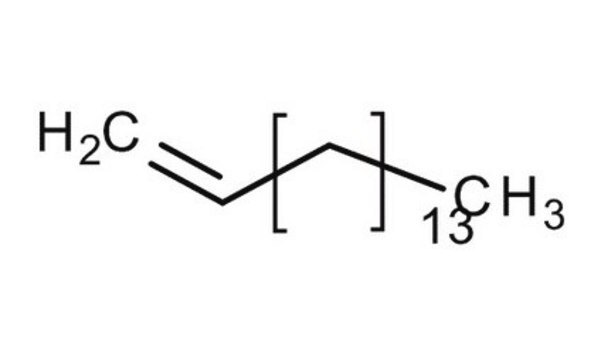All Photos(2)
About This Item
Linear Formula:
CH3(CH2)13CH=CH2
CAS Number:
Molecular Weight:
224.43
Beilstein:
1753401
EC Number:
MDL number:
UNSPSC Code:
12352100
PubChem Substance ID:
NACRES:
NA.22
Recommended Products
vapor density
>0.8 (vs air)
Quality Level
vapor pressure
<0.2 mmHg ( 20 °C)
Assay
≥98.5%
form
liquid
autoignition temp.
464 °F
refractive index
n20/D 1.441 (lit.)
bp
274 °C (lit.)
mp
3-5 °C (lit.)
density
0.783 g/mL at 25 °C (lit.)
SMILES string
CCCCCCCCCCCCCCC=C
InChI
1S/C16H32/c1-3-5-7-9-11-13-15-16-14-12-10-8-6-4-2/h3H,1,4-16H2,2H3
InChI key
GQEZCXVZFLOKMC-UHFFFAOYSA-N
Looking for similar products? Visit Product Comparison Guide
Related Categories
General description
1-Hexadecene, a long-chain alpha-olefin (LAO)containing 16 carbon atoms, commonly used as a precursor in the production ofsynthetic detergents, plasticizers, and various chemicals for the chemicalindustry. Additionally, it is a key component in commercial LAO blends,contributing to the manufacturing of tanning oils, synthetic fatty acids, anddrilling fluids.
Application
- Development of petroleum lubricating oil additives: A study evaluated newly synthesized copolymers and their montmorillonite nanocomposites as cold flow improvers for petroleum lubricating oils, including formulations with 1-Hexadecene, demonstrating enhanced flow properties (El-Bahnasawi et al., 2023).
- Attractants for biocontrol agents: Research identified volatile blends containing 1-Hexadecene that attract the biocontrol agent Galerucella placida, suggesting applications in agricultural pest management (Koner et al., 2022).
- Adsorbent materials for oil spill cleanup: A study explored the modification of commercial sponges with 1-Hexadecene-based polymers for efficient adsorption of crude oil and organic solvents, highlighting potential environmental cleanup applications (Jin et al., 2022).
- Surface engineering for hydrophobicity: 1-Hexadecene was used to create organosilane micropatterns on surfaces, improving their hydrophobic properties, relevant in material science and surface engineering (Soliman et al., 2021).
Signal Word
Danger
Hazard Statements
Precautionary Statements
Hazard Classifications
Asp. Tox. 1
Storage Class Code
10 - Combustible liquids
WGK
WGK 1
Flash Point(F)
269.6 °F - closed cup
Flash Point(C)
132 °C - closed cup
Personal Protective Equipment
dust mask type N95 (US), Eyeshields, Gloves
Choose from one of the most recent versions:
Already Own This Product?
Find documentation for the products that you have recently purchased in the Document Library.
Customers Also Viewed
Yasuyuki Kubo et al.
mBio, 6(5), e01305-e01315 (2015-09-17)
The cucumber anthracnose fungus Colletotrichum orbiculare forms specialized cells called appressoria for host penetration. We identified a gene, FAM1, encoding a novel peroxin protein that is essential for peroxisome biogenesis and that associates with Woronin bodies (WBs), dense-core vesicles found
M Tobler et al.
Contact dermatitis, 26(5), 299-303 (1992-05-01)
In continuation of our preceding studies, we disclose long-term experiments to test more extensively the protective power of the novel 4H Glove. 2 compounds encountered in modern electron microscopy technique, 1-hexadecene (1-HD) and 2-hydroxyethyl acrylate (2-HEA), which elicit allergic and/or
Contact allergy to polyvinylpyrrolidone/hexadecene copolymer previously reported.
A C De Groot
American journal of contact dermatitis : official journal of the American Contact Dermatitis Society, 7(4), 260-260 (1996-12-01)
Paroma Mitra et al.
Pest management science, 77(1), 285-299 (2020-07-23)
The viviparous aphid Aphis craccivora Koch (Hemiptera: Aphididae) is a serious threat to the crop yield of Lathyrus sativus L. (Fabaceae), commonly known as grass pea. The synthetic insecticides applied to control this insect pest are not safe for the
C Barba et al.
Meat science, 90(3), 697-700 (2011-11-22)
Solid phase microextraction (SPME) coupled with either gas chromatography-ionization flame detector (CG-FID) or multidimensional gas chromatography-mass spectrometry (MDGC-MS) was evaluated for its ability to detect volatile hydrocarbons produced during the irradiation of cooked ham. The chromatogram of an irradiated sample
Our team of scientists has experience in all areas of research including Life Science, Material Science, Chemical Synthesis, Chromatography, Analytical and many others.
Contact Technical Service









